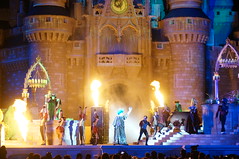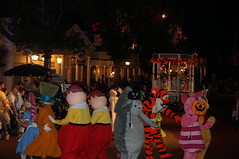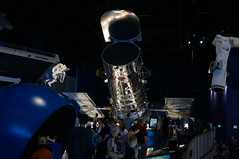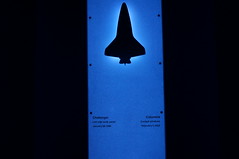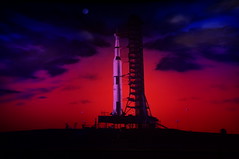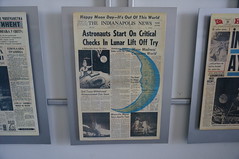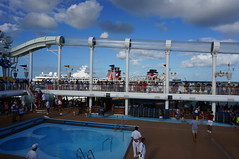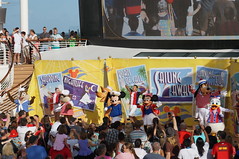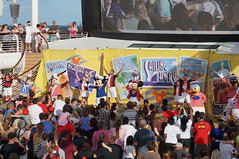Photos for Disney, Indiana Episode 192 – It Wasn’t so Scary on the Ocean Blue

Seven Dwarfs Mine Train - Barrel of Jewels
One of several barrels of jewels on display in the queue of the Seven Dwarfs Mine Train, the newest additional to New Fantasyland at the Magic Kingdom at Walt Disney World in Florida. The jewels' light shone up on the ceiling of the cave, showing short video clips featuring the seven dwarfs

Seven Dwarfs Mine Train - Barrels of Jewels
The jewel barrel display in the queue of the Seven Dwarfs Mine Train, the newest additional to New Fantasyland at the Magic Kingdom at Walt Disney World in Florida. The jewels' light shone up on the ceiling of the cave, showing short video clips featuring the seven dwarfs

Jack and Sally and Scott and Tracey
Scott and Tracey pose with Jack and Sally, the stars of the 1993 stop-motion animated film "The Nightmare Before Christmas". The photo was taken during the Mickey's Not So Scary Halloween Party - Scott was dressed as Russell from the Pixar film "Up" and Tracey was Kevin the bird from the same film.

JFK Fountain at the Kennedy Space Center Visitor Complex
The fountain, designed by Freeport Fountains of Sanford, FL, is lit in the evenings with LED lights programmed in sequence with 26 waterjets. An audio recording of an actual NASA lift-off also plays as the waterjets pulse to the blastoff sequence. The fountain’s backdrop is a 75-foot-long radial-shaped trapezoid, standing 30 feet tall at its highest point, featuring Blue Pearl granite supplied by Coldspring of Cold Spring, MN. For the project, 875 square feet of the granite was selected because it coordinates with NASA’s signature blue, and the polished finish provides an ideal surface for the laser etching that features a quote from President John F. Kennedy’s 1962 moon speech at Rice University.

Space Shuttle Atlantis
The Space Shuttle Atlantis (Orbiter Vehicle Designation: OV‑104) at the Kennedy Space Center Visitor's Complex in the Space Shuttle Atlantis building.
Atlantis was the fourth operational and the second-to-last Space Shuttle built. Its maiden flight was STS-51-J lifting off on 10/03/1985 and landing on 10/07/1985. It's, and the shuttle program's, last mission was STS-135 that lifted off on 07/08/2011 and landing at the Kennedy Space Center on 07/21/2011.
By the end of its final mission, Atlantis had orbited the Earth a total of 4,848 times, traveling nearly 126,000,000 mi (203,000,000 km) or more than 525 times the distance from the Earth to the Moon.
Atlantis is named after RV Atlantis, a two-masted sailing ship that operated as the primary research vessel for the Woods Hole Oceanographic Institution from 1930 to 1966.

Space Shuttle Atlantis
The Space Shuttle Atlantis (Orbiter Vehicle Designation: OV‑104) at the Kennedy Space Center Visitor's Complex in the Space Shuttle Atlantis building.
Atlantis was the fourth operational and the second-to-last Space Shuttle built. Its maiden flight was STS-51-J lifting off on 10/03/1985 and landing on 10/07/1985. It's, and the shuttle program's, last mission was STS-135 that lifted off on 07/08/2011 and landing at the Kennedy Space Center on 07/21/2011.
By the end of its final mission, Atlantis had orbited the Earth a total of 4,848 times, traveling nearly 126,000,000 mi (203,000,000 km) or more than 525 times the distance from the Earth to the Moon.
Atlantis is named after RV Atlantis, a two-masted sailing ship that operated as the primary research vessel for the Woods Hole Oceanographic Institution from 1930 to 1966.

Space Shuttle Atlantis
The Space Shuttle Atlantis (Orbiter Vehicle Designation: OV‑104) at the Kennedy Space Center Visitor's Complex in the Space Shuttle Atlantis building.
Atlantis was the fourth operational and the second-to-last Space Shuttle built. Its maiden flight was STS-51-J lifting off on 10/03/1985 and landing on 10/07/1985. It's, and the shuttle program's, last mission was STS-135 that lifted off on 07/08/2011 and landing at the Kennedy Space Center on 07/21/2011.
By the end of its final mission, Atlantis had orbited the Earth a total of 4,848 times, traveling nearly 126,000,000 mi (203,000,000 km) or more than 525 times the distance from the Earth to the Moon.
Atlantis is named after RV Atlantis, a two-masted sailing ship that operated as the primary research vessel for the Woods Hole Oceanographic Institution from 1930 to 1966.

Space Shuttle Atlantis
The Space Shuttle Atlantis (Orbiter Vehicle Designation: OV‑104) at the Kennedy Space Center Visitor's Complex in the Space Shuttle Atlantis building.
Atlantis was the fourth operational and the second-to-last Space Shuttle built. Its maiden flight was STS-51-J lifting off on 10/03/1985 and landing on 10/07/1985. It's, and the shuttle program's, last mission was STS-135 that lifted off on 07/08/2011 and landing at the Kennedy Space Center on 07/21/2011.
By the end of its final mission, Atlantis had orbited the Earth a total of 4,848 times, traveling nearly 126,000,000 mi (203,000,000 km) or more than 525 times the distance from the Earth to the Moon.
Atlantis is named after RV Atlantis, a two-masted sailing ship that operated as the primary research vessel for the Woods Hole Oceanographic Institution from 1930 to 1966.

Space Shuttle Atlantis
The Space Shuttle Atlantis (Orbiter Vehicle Designation: OV‑104) at the Kennedy Space Center Visitor's Complex in the Space Shuttle Atlantis building.
Atlantis was the fourth operational and the second-to-last Space Shuttle built. Its maiden flight was STS-51-J lifting off on 10/03/1985 and landing on 10/07/1985. It's, and the shuttle program's, last mission was STS-135 that lifted off on 07/08/2011 and landing at the Kennedy Space Center on 07/21/2011.
By the end of its final mission, Atlantis had orbited the Earth a total of 4,848 times, traveling nearly 126,000,000 mi (203,000,000 km) or more than 525 times the distance from the Earth to the Moon.
Atlantis is named after RV Atlantis, a two-masted sailing ship that operated as the primary research vessel for the Woods Hole Oceanographic Institution from 1930 to 1966.

Space Shuttle Atlantis
The Space Shuttle Atlantis (Orbiter Vehicle Designation: OV‑104) at the Kennedy Space Center Visitor's Complex in the Space Shuttle Atlantis building.
Atlantis was the fourth operational and the second-to-last Space Shuttle built. Its maiden flight was STS-51-J lifting off on 10/03/1985 and landing on 10/07/1985. It's, and the shuttle program's, last mission was STS-135 that lifted off on 07/08/2011 and landing at the Kennedy Space Center on 07/21/2011.
By the end of its final mission, Atlantis had orbited the Earth a total of 4,848 times, traveling nearly 126,000,000 mi (203,000,000 km) or more than 525 times the distance from the Earth to the Moon.
Atlantis is named after RV Atlantis, a two-masted sailing ship that operated as the primary research vessel for the Woods Hole Oceanographic Institution from 1930 to 1966.

Space Shuttle Atlantis
The Space Shuttle Atlantis (Orbiter Vehicle Designation: OV‑104) at the Kennedy Space Center Visitor's Complex in the Space Shuttle Atlantis building.
Atlantis was the fourth operational and the second-to-last Space Shuttle built. Its maiden flight was STS-51-J lifting off on 10/03/1985 and landing on 10/07/1985. It's, and the shuttle program's, last mission was STS-135 that lifted off on 07/08/2011 and landing at the Kennedy Space Center on 07/21/2011.
By the end of its final mission, Atlantis had orbited the Earth a total of 4,848 times, traveling nearly 126,000,000 mi (203,000,000 km) or more than 525 times the distance from the Earth to the Moon.
Atlantis is named after RV Atlantis, a two-masted sailing ship that operated as the primary research vessel for the Woods Hole Oceanographic Institution from 1930 to 1966.
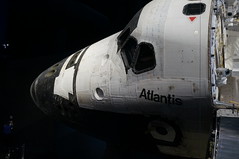
Space Shuttle Atlantis
The Space Shuttle Atlantis (Orbiter Vehicle Designation: OV‑104) at the Kennedy Space Center Visitor's Complex in the Space Shuttle Atlantis building.
Atlantis was the fourth operational and the second-to-last Space Shuttle built. Its maiden flight was STS-51-J lifting off on 10/03/1985 and landing on 10/07/1985. It's, and the shuttle program's, last mission was STS-135 that lifted off on 07/08/2011 and landing at the Kennedy Space Center on 07/21/2011.
By the end of its final mission, Atlantis had orbited the Earth a total of 4,848 times, traveling nearly 126,000,000 mi (203,000,000 km) or more than 525 times the distance from the Earth to the Moon.
Atlantis is named after RV Atlantis, a two-masted sailing ship that operated as the primary research vessel for the Woods Hole Oceanographic Institution from 1930 to 1966.

Space Shuttle Atlantis
The Space Shuttle Atlantis (Orbiter Vehicle Designation: OV‑104) at the Kennedy Space Center Visitor's Complex in the Space Shuttle Atlantis building.
Atlantis was the fourth operational and the second-to-last Space Shuttle built. Its maiden flight was STS-51-J lifting off on 10/03/1985 and landing on 10/07/1985. It's, and the shuttle program's, last mission was STS-135 that lifted off on 07/08/2011 and landing at the Kennedy Space Center on 07/21/2011.
By the end of its final mission, Atlantis had orbited the Earth a total of 4,848 times, traveling nearly 126,000,000 mi (203,000,000 km) or more than 525 times the distance from the Earth to the Moon.
Atlantis is named after RV Atlantis, a two-masted sailing ship that operated as the primary research vessel for the Woods Hole Oceanographic Institution from 1930 to 1966.

Space Shuttle Atlantis
The Space Shuttle Atlantis (Orbiter Vehicle Designation: OV‑104) at the Kennedy Space Center Visitor's Complex in the Space Shuttle Atlantis building.
Atlantis was the fourth operational and the second-to-last Space Shuttle built. Its maiden flight was STS-51-J lifting off on 10/03/1985 and landing on 10/07/1985. It's, and the shuttle program's, last mission was STS-135 that lifted off on 07/08/2011 and landing at the Kennedy Space Center on 07/21/2011.
By the end of its final mission, Atlantis had orbited the Earth a total of 4,848 times, traveling nearly 126,000,000 mi (203,000,000 km) or more than 525 times the distance from the Earth to the Moon.
Atlantis is named after RV Atlantis, a two-masted sailing ship that operated as the primary research vessel for the Woods Hole Oceanographic Institution from 1930 to 1966.

Space Shuttle Atlantis
The Space Shuttle Atlantis (Orbiter Vehicle Designation: OV‑104) at the Kennedy Space Center Visitor's Complex in the Space Shuttle Atlantis building.
Atlantis was the fourth operational and the second-to-last Space Shuttle built. Its maiden flight was STS-51-J lifting off on 10/03/1985 and landing on 10/07/1985. It's, and the shuttle program's, last mission was STS-135 that lifted off on 07/08/2011 and landing at the Kennedy Space Center on 07/21/2011.
By the end of its final mission, Atlantis had orbited the Earth a total of 4,848 times, traveling nearly 126,000,000 mi (203,000,000 km) or more than 525 times the distance from the Earth to the Moon.
Atlantis is named after RV Atlantis, a two-masted sailing ship that operated as the primary research vessel for the Woods Hole Oceanographic Institution from 1930 to 1966.

Space Shuttle Atlantis
The Space Shuttle Atlantis (Orbiter Vehicle Designation: OV‑104) at the Kennedy Space Center Visitor's Complex in the Space Shuttle Atlantis building.
Atlantis was the fourth operational and the second-to-last Space Shuttle built. Its maiden flight was STS-51-J lifting off on 10/03/1985 and landing on 10/07/1985. It's, and the shuttle program's, last mission was STS-135 that lifted off on 07/08/2011 and landing at the Kennedy Space Center on 07/21/2011.
By the end of its final mission, Atlantis had orbited the Earth a total of 4,848 times, traveling nearly 126,000,000 mi (203,000,000 km) or more than 525 times the distance from the Earth to the Moon.
Atlantis is named after RV Atlantis, a two-masted sailing ship that operated as the primary research vessel for the Woods Hole Oceanographic Institution from 1930 to 1966.

Space Shuttle Atlantis
The Space Shuttle Atlantis (Orbiter Vehicle Designation: OV‑104) at the Kennedy Space Center Visitor's Complex in the Space Shuttle Atlantis building.
Atlantis was the fourth operational and the second-to-last Space Shuttle built. Its maiden flight was STS-51-J lifting off on 10/03/1985 and landing on 10/07/1985. It's, and the shuttle program's, last mission was STS-135 that lifted off on 07/08/2011 and landing at the Kennedy Space Center on 07/21/2011.
By the end of its final mission, Atlantis had orbited the Earth a total of 4,848 times, traveling nearly 126,000,000 mi (203,000,000 km) or more than 525 times the distance from the Earth to the Moon.
Atlantis is named after RV Atlantis, a two-masted sailing ship that operated as the primary research vessel for the Woods Hole Oceanographic Institution from 1930 to 1966.

Space Shuttle Atlantis
The Space Shuttle Atlantis (Orbiter Vehicle Designation: OV‑104) at the Kennedy Space Center Visitor's Complex in the Space Shuttle Atlantis building.
Atlantis was the fourth operational and the second-to-last Space Shuttle built. Its maiden flight was STS-51-J lifting off on 10/03/1985 and landing on 10/07/1985. It's, and the shuttle program's, last mission was STS-135 that lifted off on 07/08/2011 and landing at the Kennedy Space Center on 07/21/2011.
By the end of its final mission, Atlantis had orbited the Earth a total of 4,848 times, traveling nearly 126,000,000 mi (203,000,000 km) or more than 525 times the distance from the Earth to the Moon.
Atlantis is named after RV Atlantis, a two-masted sailing ship that operated as the primary research vessel for the Woods Hole Oceanographic Institution from 1930 to 1966.

Space Shuttle Atlantis
The Space Shuttle Atlantis (Orbiter Vehicle Designation: OV‑104) at the Kennedy Space Center Visitor's Complex in the Space Shuttle Atlantis building.
Atlantis was the fourth operational and the second-to-last Space Shuttle built. Its maiden flight was STS-51-J lifting off on 10/03/1985 and landing on 10/07/1985. It's, and the shuttle program's, last mission was STS-135 that lifted off on 07/08/2011 and landing at the Kennedy Space Center on 07/21/2011.
By the end of its final mission, Atlantis had orbited the Earth a total of 4,848 times, traveling nearly 126,000,000 mi (203,000,000 km) or more than 525 times the distance from the Earth to the Moon.
Atlantis is named after RV Atlantis, a two-masted sailing ship that operated as the primary research vessel for the Woods Hole Oceanographic Institution from 1930 to 1966.

The Space Shuttle Atlantis
The Space Shuttle Atlantis (Orbiter Vehicle Designation: OV‑104) at the Kennedy Space Center Visitor's Complex in the Space Shuttle Atlantis building.
Atlantis was the fourth operational and the second-to-last Space Shuttle built. Its maiden flight was STS-51-J lifting off on 10/03/1985 and landing on 10/07/1985. It's, and the shuttle program's, last mission was STS-135 that lifted off on 07/08/2011 and landing at the Kennedy Space Center on 07/21/2011.
By the end of its final mission, Atlantis had orbited the Earth a total of 4,848 times, traveling nearly 126,000,000 mi (203,000,000 km) or more than 525 times the distance from the Earth to the Moon.
Atlantis is named after RV Atlantis, a two-masted sailing ship that operated as the primary research vessel for the Woods Hole Oceanographic Institution from 1930 to 1966.

NASA Vehicle Assembly Building
The Vehicle (originally Vertical) Assembly Building, or VAB, at NASA's Kennedy Space Center (KSC) is a building designed to assemble large space vehicles, such as the massive Saturn V and the Space Shuttle. The future Space Launch System (SLS) will also be assembled there.
At 3,664,883 cubic meters (129,428,000 cubic feet) it is one of the largest buildings in the world by volume. The VAB is the largest single-story building in the world, was the tallest building (160.3 m) in Florida until 1974, and is still the tallest building in the United States outside an urban area.

Mobile Launcher Platform (MLP)
The Space Shuttle Mobile Launcher Platform (MLP). Each MLP weighs 3,730,000 kg (8,230,000 lb) unloaded and roughly 5,000,000 kg (11,000,000 lb) with an unfueled Shuttle aboard, measures 49 by 41 m (160 by 135 ft), and is 7.6 m (25 ft) high.
The Mobile Launcher Platform was set atop six legs, each 6.7 m (22 ft) tall, when stationary. The Solid Rocket Boosters were mounted on top of the MLP. The External Tank was then lowered between the two boosters and attached to them. After that, the orbiter was lowered into position and attached to the External Tank. The crawler-transporter then carried the combined platform and vehicle to the launch site, and deposited them there together. Once the launch was completed, the crawler-transporter retrieved the empty MLP from the pad to be readied for its next use.

Space Shuttle Mobile Launcher Platform (MLP)
The Space Shuttle Mobile Launcher Platform (MLP). Each MLP weighs 3,730,000 kg (8,230,000 lb) unloaded and roughly 5,000,000 kg (11,000,000 lb) with an unfueled Shuttle aboard, measures 49 by 41 m (160 by 135 ft), and is 7.6 m (25 ft) high.
The Mobile Launcher Platform was set atop six legs, each 6.7 m (22 ft) tall, when stationary. The Solid Rocket Boosters were mounted on top of the MLP. The External Tank was then lowered between the two boosters and attached to them. After that, the orbiter was lowered into position and attached to the External Tank. The crawler-transporter then carried the combined platform and vehicle to the launch site, and deposited them there together. Once the launch was completed, the crawler-transporter retrieved the empty MLP from the pad to be readied for its next use.

Launch Complex 39 (LC-39)
Launch Complex 39 (LC-39) is a rocket launch site at the John F. Kennedy Space Center on Merritt Island in Florida, USA. The site and its collection of facilities were originally built for the Apollo program, and later modified for the Space Shuttle program, before undergoing modifications to support launches of the SpaceX Falcon 9 and Falcon Heavy, and NASA's Space Launch System.

Launch Complex 39 (LC-39)
Launch Complex 39 (LC-39) is a rocket launch site at the John F. Kennedy Space Center on Merritt Island in Florida, USA. The site and its collection of facilities were originally built for the Apollo program, and later modified for the Space Shuttle program, before undergoing modifications to support launches of the SpaceX Falcon 9 and Falcon Heavy, and NASA's Space Launch System.

NASA Crawler-Transporter
The crawler-transporter has a mass of 2,721,000 kilograms (5,999,000 lb) and has eight tracks, two on each corner. Each track has 57 shoes, and each shoe weighs 900 kg (1,984 lb). The vehicle measures 40 by 35 metres (131 by 114 ft). The height from ground level to the platform is adjustable from 6.1 to 7.9 m (20 to 26 ft), and each side can be raised and lowered independently of the other. The crawler uses a laser guidance system and a leveling system to keep the Mobile Launcher Platform level within 10 minutes of arc (about 30 cm (1 ft) at the top of the Saturn V), while moving up the 5% grade to the launch site. A separate laser docking system provides pinpoint accuracy when the crawler-transporter and Mobile Launch Platform are positioned in the VAB or at the launch pad. A team of nearly 30 engineers, technicians and drivers operate the vehicle.
They were originally used to transport the Saturn IB and Saturn V rockets during the Apollo, Skylab and Apollo–Soyuz programs. They were then used to transport Space Shuttles from 1981 to 2011. The crawler-transporters carry vehicles on the Mobile Launcher Platform, and after each launch return to the pad to take the platform back to the VAB.
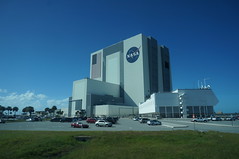
NASA's Vehicle Assembly Building
The Vehicle (originally Vertical) Assembly Building, or VAB, at NASA's Kennedy Space Center (KSC) is a building designed to assemble large space vehicles, such as the massive Saturn V and the Space Shuttle. The future Space Launch System (SLS) will also be assembled there.
At 3,664,883 cubic meters (129,428,000 cubic feet) it is one of the largest buildings in the world by volume. The VAB is the largest single-story building in the world, was the tallest building (160.3 m) in Florida until 1974, and is still the tallest building in the United States outside an urban area.

NASA's Vehicle Assembly Building
The Vehicle (originally Vertical) Assembly Building, or VAB, at NASA's Kennedy Space Center (KSC) is a building designed to assemble large space vehicles, such as the massive Saturn V and the Space Shuttle. The future Space Launch System (SLS) will also be assembled there.
At 3,664,883 cubic meters (129,428,000 cubic feet) it is one of the largest buildings in the world by volume. The VAB is the largest single-story building in the world, was the tallest building (160.3 m) in Florida until 1974, and is still the tallest building in the United States outside an urban area.

The Firing Room Theater at the Apollo Saturn V Center
The Firing Room Theater at the Apollo Saturn V Center. Here is the actual consoles used during the Apollo launches – not far from Kennedy Space Center’s real launch control center.
Here we also experienced what is was like on 12/21/1968 for the launch of Apollo 8.

The Firing Room Theater at the Apollo Saturn V Center
The Firing Room Theater at the Apollo Saturn V Center. Here is the actual consoles used during the Apollo launches – not far from Kennedy Space Center’s real launch control center.
Here we also experienced what is was like on 12/21/1968 for the launch of Apollo 8.

Apollo Saturn V Rocket
Saturn V Rocket at the Apollo Saturn V Center at the Kennedy Space Center.
The Saturn V (spoken as "Saturn five") was an American human-rated expendable rocket used by NASA between 1966 and 1973. The three-stage liquid-fueled launch vehicle was developed to support the Apollo program for human exploration of the Moon, and was later used to launch Skylab, the first American space station. The Saturn V was launched 13 times from the Kennedy Space Center in Florida with no loss of crew or payload. The Saturn V remains the tallest, heaviest, and most powerful rocket ever brought to operational status and still holds records for the heaviest payload launched and largest payload capacity to low Earth orbit (LEO) of 310,000 pounds (140,000 kg)

Apollo Saturn V Rocket
Saturn V Rocket at the Apollo Saturn V Center at the Kennedy Space Center.
The Saturn V (spoken as "Saturn five") was an American human-rated expendable rocket used by NASA between 1966 and 1973. The three-stage liquid-fueled launch vehicle was developed to support the Apollo program for human exploration of the Moon, and was later used to launch Skylab, the first American space station. The Saturn V was launched 13 times from the Kennedy Space Center in Florida with no loss of crew or payload. The Saturn V remains the tallest, heaviest, and most powerful rocket ever brought to operational status and still holds records for the heaviest payload launched and largest payload capacity to low Earth orbit (LEO) of 310,000 pounds (140,000 kg)

Apollo Saturn V Rocket - Size Details
Saturn V Rocket at the Apollo Saturn V Center at the Kennedy Space Center.
The Saturn V (spoken as "Saturn five") was an American human-rated expendable rocket used by NASA between 1966 and 1973. The three-stage liquid-fueled launch vehicle was developed to support the Apollo program for human exploration of the Moon, and was later used to launch Skylab, the first American space station. The Saturn V was launched 13 times from the Kennedy Space Center in Florida with no loss of crew or payload. The Saturn V remains the tallest, heaviest, and most powerful rocket ever brought to operational status and still holds records for the heaviest payload launched and largest payload capacity to low Earth orbit (LEO) of 310,000 pounds (140,000 kg)

Apollo Saturn V Rocket - Weight Details
Saturn V Rocket at the Apollo Saturn V Center at the Kennedy Space Center.
The Saturn V (spoken as "Saturn five") was an American human-rated expendable rocket used by NASA between 1966 and 1973. The three-stage liquid-fueled launch vehicle was developed to support the Apollo program for human exploration of the Moon, and was later used to launch Skylab, the first American space station. The Saturn V was launched 13 times from the Kennedy Space Center in Florida with no loss of crew or payload. The Saturn V remains the tallest, heaviest, and most powerful rocket ever brought to operational status and still holds records for the heaviest payload launched and largest payload capacity to low Earth orbit (LEO) of 310,000 pounds (140,000 kg)

Apollo Saturn V Rocket - Fuel Details
Saturn V Rocket at the Apollo Saturn V Center at the Kennedy Space Center.
The Saturn V (spoken as "Saturn five") was an American human-rated expendable rocket used by NASA between 1966 and 1973. The three-stage liquid-fueled launch vehicle was developed to support the Apollo program for human exploration of the Moon, and was later used to launch Skylab, the first American space station. The Saturn V was launched 13 times from the Kennedy Space Center in Florida with no loss of crew or payload. The Saturn V remains the tallest, heaviest, and most powerful rocket ever brought to operational status and still holds records for the heaviest payload launched and largest payload capacity to low Earth orbit (LEO) of 310,000 pounds (140,000 kg)

NASA's Vehicle Assembly Building - From the Apollo Saturn V Center
The Vehicle (originally Vertical) Assembly Building, or VAB, at NASA's Kennedy Space Center (KSC) is a building designed to assemble large space vehicles, such as the massive Saturn V and the Space Shuttle. The future Space Launch System (SLS) will also be assembled there.
At 3,664,883 cubic meters (129,428,000 cubic feet) it is one of the largest buildings in the world by volume. The VAB is the largest single-story building in the world, was the tallest building (160.3 m) in Florida until 1974, and is still the tallest building in the United States outside an urban area.

The Muppets Call Board
The Muppets call board that plays a part in the Midship Detective Agency on the Disney Fantasy cruise ship. Several clues can be found as you try to solve the case of the stolen show.
The game is an interactive quest around the ship via pieces of "Enchanted Art" and physical clues. The goal of the game is for ship passengers to help the Muppets find their missing props so that they can put on a big show. Guests are aided by a map and a game card that reveals clues when held up in front of some of the Enchanted Art pieces.

























